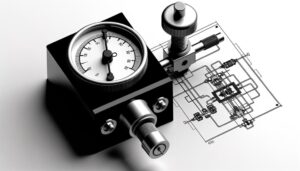What Does the Upside Down V Symbol Mean on a Car Dashboard?
The upside-down V symbol on your car dashboard typically refers to the vehicle's stability control system or advanced driver-assistance features. This symbol resembles an inverted chevron and indicates potential issues with traction control, which can affect your vehicle's stability and handling.
Causes for activation include malfunctioning sensors, software glitches, or hydraulic system degradation. Immediate attention to this alert is vital to maintain safety and prevent further damage.
Understanding dashboard symbols is essential for vehicle longevity and safety, and there are further insights and measures that can help you respond effectively to this warning.
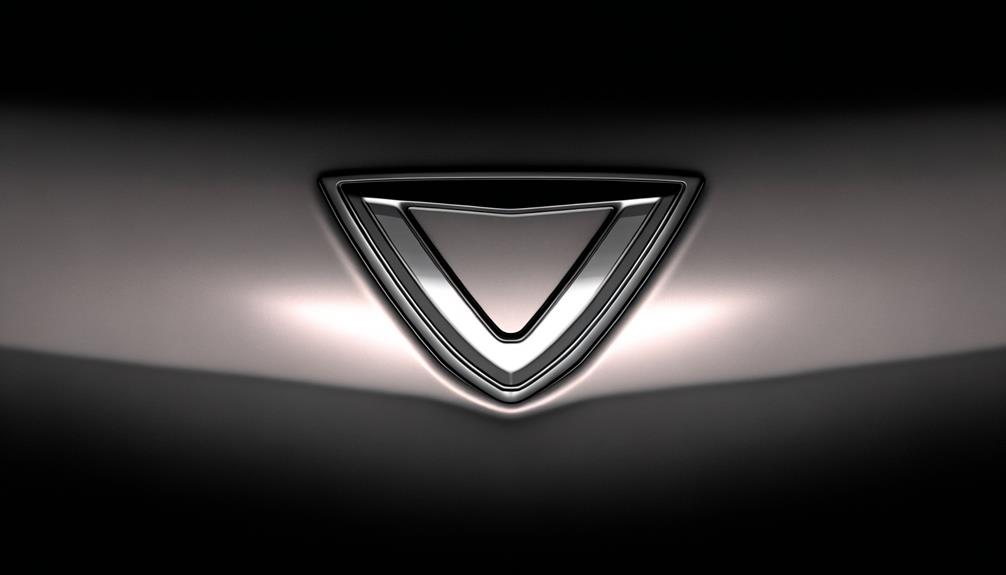
Key Takeaways
- The upside-down V symbol often indicates issues with vehicle stability control systems.
- It resembles an inverted chevron, symbolizing motion, stability, and directionality.
- Common causes include malfunctioning sensors, degraded hydraulic systems, or software glitches.
- When illuminated, it may signify traction control system problems compromising handling and stability.
- Prompt attention to this symbol can prevent further mechanical failures and ensure road safety.
Understanding Dashboard Symbols
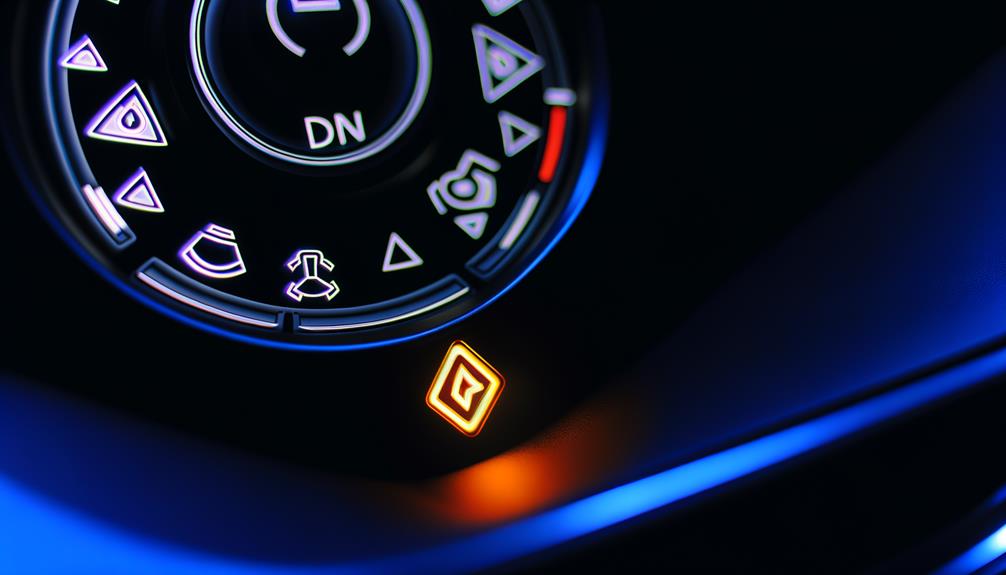
Dashboard symbols are an essential aspect of modern vehicles, serving as a communication bridge between the car's intricate systems and the driver. These symbols, often illuminated on the dashboard, provide critical information regarding the vehicle's operational status and alert the driver to potential issues.
Understanding these symbols is paramount for ensuring vehicle safety and performance. Each symbol is meticulously designed to convey specific messages, from routine notifications like low fuel to urgent warnings such as engine malfunctions. The complexity of automotive technology necessitates that drivers familiarize themselves with these indicators.
Common Warning Lights
Understanding common warning lights is vital for maintaining your vehicle's health and ensuring road safety.
Key indicators such as the Engine Check Light, Battery Alert Indicator, and Brake System Warning provide immediate alerts that require prompt attention.
This section will analyze these symbols, their implications, and the necessary actions to address them effectively.
Engine Check Light
Triggered by a variety of potential issues, the engine check light is one of the most critical warning indicators on a vehicle's dashboard. This light can illuminate due to minor issues, such as a loose gas cap, or more severe problems like malfunctioning oxygen sensors, catalytic converter failure, or engine misfires.
Diagnosing the exact cause typically requires an OBD-II scanner, which reads error codes stored in the vehicle's computer. Ignoring this warning can lead to decreased fuel efficiency, increased emissions, and potentially costly repairs. Hence, timely attention is imperative.
Battery Alert Indicator
The Battery Alert Indicator, often represented by a battery symbol, signals potential issues within the vehicle's charging system that demand immediate attention. When illuminated, it indicates that the battery is not being charged adequately, which could result from a faulty alternator, worn-out battery, or corroded terminals.
Ignoring this alert may lead to a complete battery drain, leaving the vehicle inoperable. To diagnose the problem, begin by examining the battery and alternator connections for any visible damage or loose connections. Furthermore, a professional diagnostic test can help pinpoint the exact issue.
Addressing this warning promptly ensures the longevity of your vehicle's electrical components and prevents inconvenient breakdowns. Understanding and acting on the Battery Alert Indicator is essential for maintaining vehicle reliability.
Brake System Warning
A vital component of vehicle safety, the Brake System Warning light signals potential issues within the braking system that necessitate immediate attention. This warning light can indicate various problems, from low brake fluid levels to worn brake pads or more severe hydraulic issues. Understanding the potential implications of this warning is essential for maintaining vehicular safety and preventing costly repairs.
| Potential Issue | Indication | Immediate Action Required |
|---|---|---|
| Low Brake Fluid | Brake pedal feels spongy | Check fluid levels |
| Worn Brake Pads | Squealing or grinding noise | Inspect and replace pads |
| Hydraulic System Fault | Persistent brake warning light | Seek professional diagnosis |
Ignoring this warning can compromise braking efficiency, leading to dangerous driving conditions.
Identifying the Upside-Down V

In automotive symbols, recognizing the upside-down V often involves understanding its context and design variations. This symbol may appear on a vehicle's dashboard or other vital system indicators. It is typically characterized by a prominent inverted V shape, sometimes accompanied by additional elements such as lines or exclamation marks, which can alter its connotation.
Paying close attention to the color, placement, and surrounding icons is vital for accurate identification. For instance, this symbol might be integrated within a larger graphic, making it pivotal to analyze the entire display.
Meaning of the Symbol
The 'upside-down V' symbol, often depicted as an inverted chevron, carries specific meanings that vary by manufacturer and context. Typically, this symbol is used to indicate advanced driver-assistance features or stability control systems.
Understanding its visual representation and common usage can help drivers recognize potential warning indicators and respond appropriately to guarantee vehicle safety.
Symbol's Visual Representation
Understanding the visual representation of the upside-down V symbol on a car requires delving into its historical context and the specific meanings attributed to it by various automakers.
This symbol, often resembling an inverted chevron, is carefully designed to convey a sense of motion, stability, and directionality. Its sharp, angular lines suggest precision and forward-thinking, making it an apt choice for brands emphasizing innovation and performance.
The symbol's simplicity allows for versatile application across different models and marketing materials, enhancing brand recognition. Its geometric form can evoke notions of strength and resilience, aligning with the values of durability and reliability that many car manufacturers aim to project.
This thoughtful design serves both aesthetic and functional purposes.
Common Manufacturer Usage
Many automakers have adopted the upside-down V symbol to encapsulate their brand identity and communicate specific values to their audience. This geometric form, often seen in logos, embodies dynamism and forward momentum.
For instance, it is utilized by premium brands to signify innovation, precision, and cutting-edge technology. The streamlined design evokes a sense of speed and efficiency, aligning the brand with high performance and modernity. Additionally, the symbol can reflect architectural strength and stability, suggesting reliability and durability.
Through this minimalist yet powerful emblem, manufacturers create a visual shorthand that resonates with consumers, delivering implicit promises of quality and advanced engineering. Consequently, the upside-down V serves as a versatile, effective tool in automotive branding.
Potential Warning Indicators
When illuminated on the dashboard, the upside-down V symbol can signify various warning indicators that demand immediate attention to guarantee vehicle safety and performance. This symbol often points to issues within the vehicle's traction control system, alerting the driver to potential malfunctions that could compromise handling and stability.
For example, it may indicate that the system is either deactivated or experiencing a fault, which can be particularly hazardous in slippery or uneven driving conditions. Additionally, it could also relate to the Anti-lock Braking System (ABS), suggesting a need for diagnostic evaluation.
Promptly addressing these alerts can prevent further mechanical failures and ensure that the vehicle operates within best safety parameters. Understanding these warnings is essential for maintaining road safety and vehicle longevity.
Causes of Activation
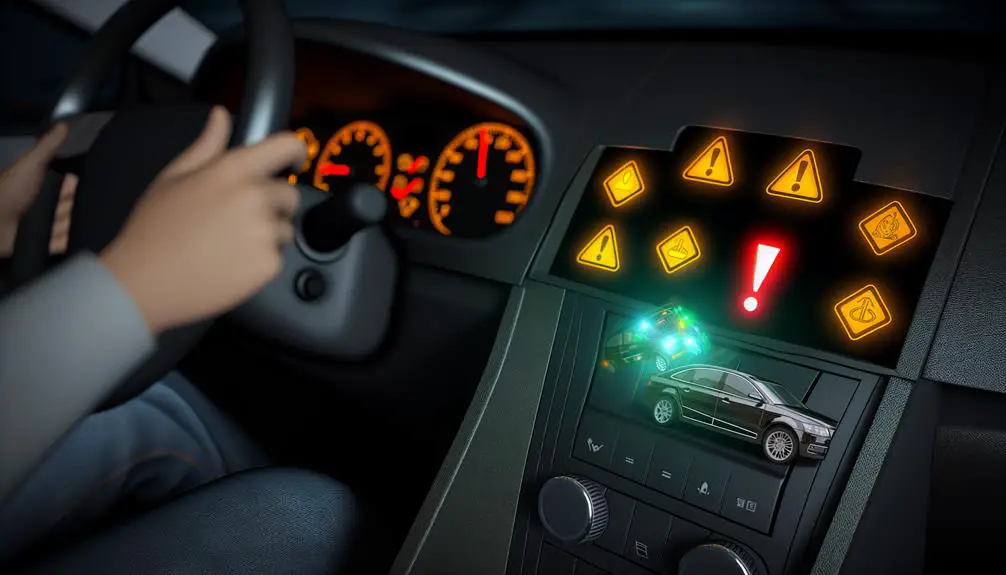
The activation of the car symbol resembling an upside-down V can be attributed to several technical and situational factors that warrant immediate attention.
Primarily, this symbol often signifies issues related to vehicle stability control systems. Malfunctioning sensors, degraded hydraulic systems, or software glitches within the stability control module are common technical causes.
Situational factors include driving on slippery or uneven surfaces, where the system is activated to maintain vehicular stability. Additionally, improper tire pressure or uneven tire wear can trigger the symbol.
Understanding these causes is essential for diagnosing and resolving underlying issues efficiently, thereby ensuring the vehicle's best performance and safety. Each factor highlights the importance of regular maintenance and timely intervention to prevent further complications.
Immediate Actions to Take
Upon noticing the car symbol resembling an upside-down V, it is important to first make sure the safety of yourself and your passengers by pulling over to a secure location.
Once safely stopped, take the following immediate actions to address the warning indicator:
- Turn off the engine: Allow the vehicle to cool down, in case the symbol relates to overheating.
- Consult the owner's manual: Verify the meaning of the warning symbol specific to your vehicle's make and model.
- Check for visible issues: Perform a quick visual inspection for any obvious problems, such as fluid leaks or loose components.
- Contact roadside assistance: If unsure about the issue, seek professional help to avoid further complications.
- Avoid driving until resolved: Do not resume driving until the problem is identified and rectified.
Checking Vehicle Systems
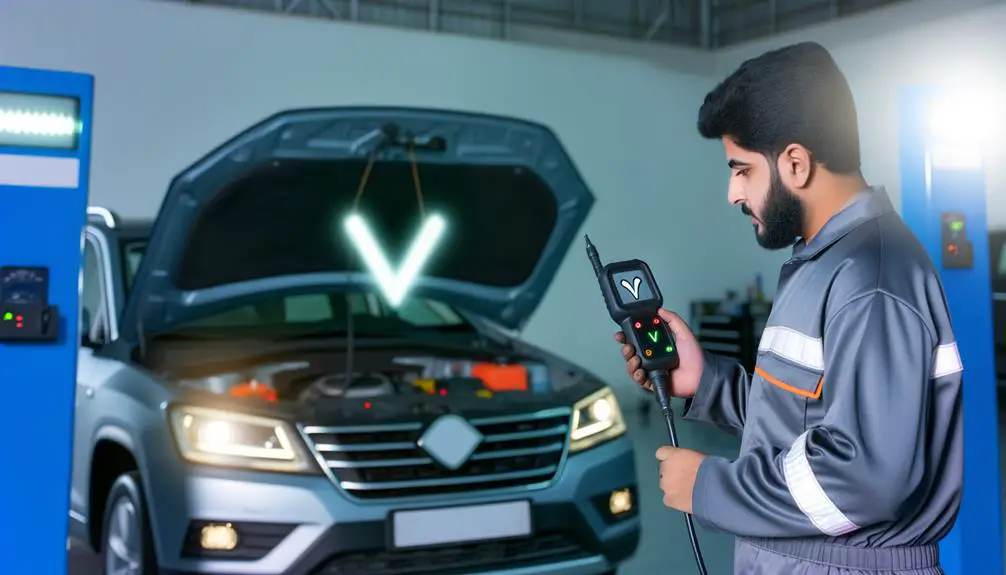
Thoroughly checking your vehicle systems is essential for diagnosing the cause behind the upside-down V warning symbol and ensuring safe operation. Begin by examining the vehicle's tire pressure and alignment, as these are common triggers for such warnings.
Next, inspect the brake system, including fluid levels and pad condition, to rule out any safety concerns. Additionally, review the suspension components for wear or damage.
Modern vehicles are equipped with onboard diagnostics (OBD) systems; utilizing an OBD scanner can provide specific error codes related to the warning symbol. This exhaustive approach allows you to identify potential issues, maintain vehicle reliability, and preempt further complications.
Always refer to your vehicle's manual for system-specific guidance and recommendations.
Professional Diagnostics
Engaging a professional diagnostic service can provide a thorough analysis of the upside-down V warning symbol, leveraging advanced tools and expertise to accurately identify underlying issues. Certified technicians utilize cutting-edge diagnostic equipment to interpret the data from your vehicle's onboard computer system. This all-encompassing approach guarantees precise detection and resolution of potential problems that may not be apparent through basic inspections.
Key benefits of professional diagnostics include:
- Accurate Identification: Pinpoints precise issues, reducing guesswork.
- Advanced Technology: Utilizes state-of-the-art tools for in-depth analysis.
- Expert Knowledge: Certified technicians with specialized training.
- Time Efficiency: Faster problem resolution compared to DIY methods.
- Preventive Insights: Identifies emerging issues before they escalate.
Preventative Maintenance Tips

Preventative maintenance is critical for ensuring your vehicle's longevity and best performance. Regular oil changes, tire pressure checks, and brake system inspections are essential practices that can prevent costly repairs and enhance safety.
This section will provide actionable insights into each of these maintenance tasks.
Regular Oil Changes
Regular oil changes are vital to maintaining the longevity and performance of your vehicle's engine. By routinely replacing the engine oil, you ensure that the moving parts are well-lubricated, reducing friction and preventing wear. This simple preventive measure can save you from costly repairs down the line.
Key benefits of regular oil changes include:
- Enhanced Engine Performance: Fresh oil optimizes engine function and efficiency.
- Improved Fuel Efficiency: Clean oil reduces engine strain, leading to better fuel economy.
- Extended Engine Life: Regular maintenance helps prevent build-up and corrosion.
- Reduced Emissions: Clean oil contributes to lower exhaust emissions.
- Maintenance of Warranty: Many warranties require adherence to recommended oil change schedules.
Tire Pressure Checks
Maintaining the correct tire pressure is essential for ensuring ideal vehicle performance, safety, and fuel efficiency. Regularly checking tire pressure can prevent uneven tire wear, reduce the risk of tire blowouts, and improve your vehicle's handling. To help you keep track, here are recommended guidelines:
| Frequency | Action |
|---|---|
| Weekly | Check tire pressure |
| Monthly | Inspect for tire damage |
| Every 6 months | Rotate tires |
| During temperature changes | Adjust pressure as needed |
Adhering to these guidelines can prolong tire life and enhance driving safety. Always refer to your vehicle's manual for the recommended tire pressure and use a reliable gauge for accurate measurements. Ensuring prime tire pressure is a simple yet crucial step in preventative maintenance.
Brake System Inspections
A thorough examination of the brake system is crucial for guaranteeing vehicle safety and peak braking performance. Regular maintenance can prevent expensive repairs and hazardous situations.
Key components to inspect include:
- Brake Pads and Shoes: Check for wear and replace if needed.
- Brake Fluid: Examine fluid levels and quality; replace if tainted.
- Rotors and Drums: Look for indications of warping or excessive wear.
- Brake Lines and Hoses: Confirm there are no leaks or cracks.
- Calipers: Verify they are operating correctly and not seizing.
When to Seek Help
If the upside-down V car symbol persists despite basic troubleshooting, it is crucial to seek professional automotive assistance to prevent potential damage or safety issues.
Persistent warning lights can indicate underlying issues that may not be immediately apparent but could escalate into more serious problems. A qualified technician possesses the specialized tools and expertise to accurately diagnose and address the root cause.
Ignoring such warnings can compromise vehicle performance, safety, and could result in costly repairs down the line. Early intervention not only ensures your vehicle functions at its best but also maintains its longevity.
Consult your vehicle's manual for recommended service intervals and seek reputable service centers that specialize in your car's make and model for the best results.
Resetting the Warning Light

Resetting the warning light often requires a combination of specific steps outlined in your vehicle's manual and the use of diagnostic tools to make certain the issue has been properly addressed. This process can be intricate and should be approached methodically to guarantee safety and accuracy.
Key steps include:
- Consult the manual: Identify the specific procedure for your vehicle model.
- Use an OBD-II scanner: Connect the scanner to diagnose and clear error codes.
- Address underlying issues: Verify any root causes of the warning light are resolved.
- Disconnect the battery: Reset the electrical system if needed.
- Test drive: Confirm the warning light does not reappear.
Following these steps guarantees the warning light is reset correctly and the vehicle operates safely.
Conclusion
In summation, the dashboard symbol resembling an upside-down V serves as an important indicator of vehicular health, requiring prompt attention. Understanding its meaning and causes can prevent more severe mechanical failures.
Through professional diagnostics and commitment to preventative maintenance, one can reduce the risk of activation. Ignoring this symbol is akin to ignoring a canary in a coal mine, highlighting the significance of timely intervention to guarantee vehicular safety and functionality.

